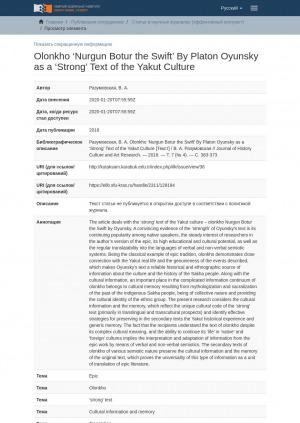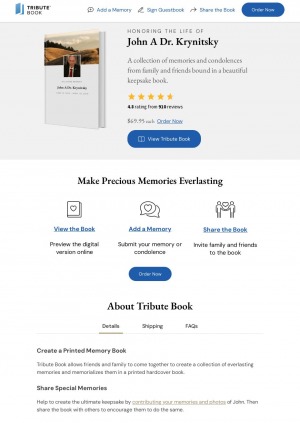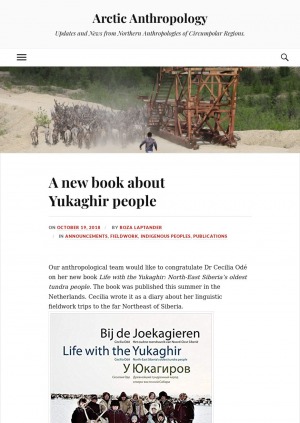- Книга (1235)
- Журнал (5)
- Автореферат диссертации (64)
- Аудиоиздание (25)
- Видеоиздание (78)
- Неопубликованный документ (2)
- Нотное издание (3)
- Фотография (11)
- Статья (364)
- Библиографический указатель (13)
- Словарь (2)
- Календарь (1)
- Брошюра (23)
- Буклет (12)
- Электронное издание (2)
- 3D-модель (17)
- Грампластинка (5)
- Веб-архив (247)
Количество страниц: 15 с.
Dobzhanskaya, O/ E. The Living Has Sound. The Dead Is Silent / Oksana E. Dobzhanskaya ; Moscow State University // Anthropology & archeology of Eurasia. - 2016, Т. 55, N 1. - С. 7-21. - DOI: http://dx.doi.org/10.1080/10611959.2016.1263485
DOI: http://dx.doi.org/10.1080/10611959.2016.1263485
Год выпуска: 2018
В 1997 и в 2017 годах в Эвенкии были проведены комплексные исследования по современным этническим процессам с использованием метода массового опроса. Выявлены существенные изменения в хозяйстве, в разных областях материальной и духовной культуры. Резко снизилось значение оленеводства, в настоящее время в нем заняты около 1/10 части эвенкийских семей. Лучше сохранились охота и рыболовство, в них занята почти треть мужчин. На любительском уровне охотой и рыболовством занимается подавляющее большинство мужчин, а значительная часть женщин не утеряли навыков шитья и вышивки бисером. Активно идет процесс языковой ассимиляции, дети практически не говорят на языке эвенков и не понимают его, хотя большинство эвенков изучает родной язык в школе. Количество национально-смешанных семей, в основном с русскими, приблизилось к половине всех семей, большинство детей вливаются в эвенкийский этнос. В результате этих браков доля метисов среди эвенков приближается к 2/3, а среди детей их доля достигла 9/10. Эвенки превращаются в группу русскоязычных метисов, но с устойчивым этническим самосознанием и с сохранением элементов традиционной культуры в некоторых областях материальной и духовной культуры
Год выпуска: 2022
Целью и задачами статьи является выявление основных способов перевода на русский текста якутского героического эпоса олонхо "Ала-Булкун", осуществленного якутским лингвистом и писателем Г.В. Баишевым-Алтан-Сарын (1898-1931). В качестве материала исследования были выбраны глаголы движения и некоторые основные эпические формулы, использованные в данном олонхо. Анализ способов перевода на русский язык якутских глаголов движения показывает, что эти глаголы переведены на русский язык способом замены. Подобный факт свидетельствует о том, что переводчик стремился точно передать семантику якутских глагольных форм на русский язык. Это, свою очередь, обусловлено тем, что глагольные формы как предикативные структуры являются вершинами тех или иных предикативных конструкций – зависимых или независимых. Эпические формулы переведены при помощи синтаксической замены – параллелизмами, а также расчленением предложения на несколько предложений. Кроме того, встречаются лексические и синтаксические повторы для расширения контекста с целью более медленного раскрытия передаваемой информации. Установлено, что в рассмотренном переводном тексте имеют место элементы авторизованного перевода. Изучение особенностей подобных переводов олонхо, ориентированных на воспроизведение стилистических и поэтических особенностей данного жанра якутского фольклора, имеет как практическое, так и теоретическое значение
Год выпуска: 2022
Настоящая статья представляет формирование субэтнической группы якутов в исследовательской траектории: ландшафт, история, память и посвящена изучению периферийной этнолокальной группы ессейских якутов, компактно проживающих на озере Ессей Красноярского края с XVIII века. На основе полевых материалов реализованы методы опроса, картографирования, глубинного интервью, введены в научный оборот ранее не опубликованные архивные материалы, нарративные источники
Год выпуска: 2014
Автор исследует проблему (не)переводимости в контексте кросс-культурной коммуникации и перевода как средства межкультурного контакта. Проблема (не)переводимости рассматривается с точки зрения Вильгельма фон Гумбольдта, который считал язык Һвыражением духа нацииһ, и гипотезы лингвистической относительности, которая определяет язык как "медиатор мысли". Настоящее исследование является частью крупного проекта по переводу олонхо – якутского (саха) героического эпоса "Нюргун Боотур Стремительный" П. А. Ойунского. В статье проводится анализ различных языковых и культурных барьеров, дается краткое описание олонхо
Год выпуска: 2018
В статье рассматривается "сильный" текст якутской культуры - олонхо "Нюргун Боотур Стремительный" Ойунского. Убедительным свидетельством "силы" текста Ойунского является его неизменная популярность среди носителей языка, устойчивый интерес исследователей к авторской версии эпоса, его высокий образовательный и культурный потенциал, а также регулярная переводимость на языки вербальной и невербальной семиотических систем. Являясь классическим образцом эпической традиции, олонхо демонстрирует тесную связь с реальной жизнью якутов и подлинность описываемых событий, что делает текст Ойунского надежным историко-этнографическим источником сведений о культуре и истории народа саха. Наряду с культурной информацией важное место в сложном информационном континууме олонхо занимает культурная память, возникающая в результате мифологизации и сакрализации прошлого коренного народа саха, имеющая коллективный характер и обеспечивающая культурную идентичность этнической группы. В настоящем исследовании рассматриваются культурная информация и память, отражающие уникальный культурный код "сильного" текста (прежде всего в транслингвистической и транскультурной перспективах), и выявляются эффективные стратегии сохранения во вторичных текстах якутского исторического опыта и родовой памяти. Понимание реципиентами текста олонхо, несмотря на его сложный культурный смысл, и способность продолжать его "жизнь" в "родной" и "чужой" культурах предполагает интерпретацию и адаптацию информации эпического произведения средствами вербальной и невербальной семиотики. Вторичные тексты олонхо различной семиотической природы сохраняют культурную информацию и память об оригинальном тексте, что доказывает универсальность данного типа информации как единицы перевода эпической литературы
Год выпуска: 2016
В статье рассматриваются стратегии перевода лексических единиц якутского героического эпоса "Дьулуруйар Ньургун Боотур" П. А. Ойунского на английский язык. Авторы дают краткую информацию об истории олонхо. Приводятся различные определения термина "стратегия перевода". Исследуются примеры применения метода компонентного анализа при переводе образных и парных слов. В статье также даются определения этих терминов. Безэквивалентная лексика рассматривается как одна из основных лексических проблем, с которыми сталкивается переводчик при переводе эпических текстов
Год выпуска: 2006
Год выпуска: 2018









